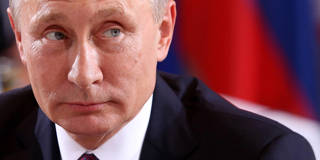In their rhetoric as well as in their military investment, training, and deployment decisions, China and Russia have both clearly signaled their aggressive strategic intentions. The task now is to ensure that their misguided militarism does not upend longstanding security arrangements in East Asia and Europe.
STOCKHOLM – The vastness of Eurasia is becoming bracketed by belligerence. On the western front, Russia has deployed a growing number of military units to the regions near its border with Ukraine, inviting a flurry of speculation about its motives. And in the east, China’s behavior vis-à-vis Taiwan has grown increasingly worrisome. A widely reported war-game study by a US think tank concludes that the United States would have “few credible options” were China to launch a sustained attack against the island.
In both cases, the aggressor’s strategic intent is clear. Chinese President Xi Jinping’s government has made a point of calling for Chinese “reunification,” regarding that as a fitting conclusion to the Chinese civil war. After World War II, the Communist Party of China took over the Chinese mainland but failed to eliminate Chiang Kai-shek’s Nationalists. They retreated to Taiwan (and some smaller islands), which has remained outside CPC rule ever since.
Sometimes, China’s official declarations about “reunification” have stipulated that it should be achieved peacefully; but on other occasions, China’s leaders have dropped the adverb. Moreover, in expanding and equipping its military, China has focused specifically on building its capacity to subdue Taiwan if it ever tries to declare independence.

STOCKHOLM – The vastness of Eurasia is becoming bracketed by belligerence. On the western front, Russia has deployed a growing number of military units to the regions near its border with Ukraine, inviting a flurry of speculation about its motives. And in the east, China’s behavior vis-à-vis Taiwan has grown increasingly worrisome. A widely reported war-game study by a US think tank concludes that the United States would have “few credible options” were China to launch a sustained attack against the island.
In both cases, the aggressor’s strategic intent is clear. Chinese President Xi Jinping’s government has made a point of calling for Chinese “reunification,” regarding that as a fitting conclusion to the Chinese civil war. After World War II, the Communist Party of China took over the Chinese mainland but failed to eliminate Chiang Kai-shek’s Nationalists. They retreated to Taiwan (and some smaller islands), which has remained outside CPC rule ever since.
Sometimes, China’s official declarations about “reunification” have stipulated that it should be achieved peacefully; but on other occasions, China’s leaders have dropped the adverb. Moreover, in expanding and equipping its military, China has focused specifically on building its capacity to subdue Taiwan if it ever tries to declare independence.